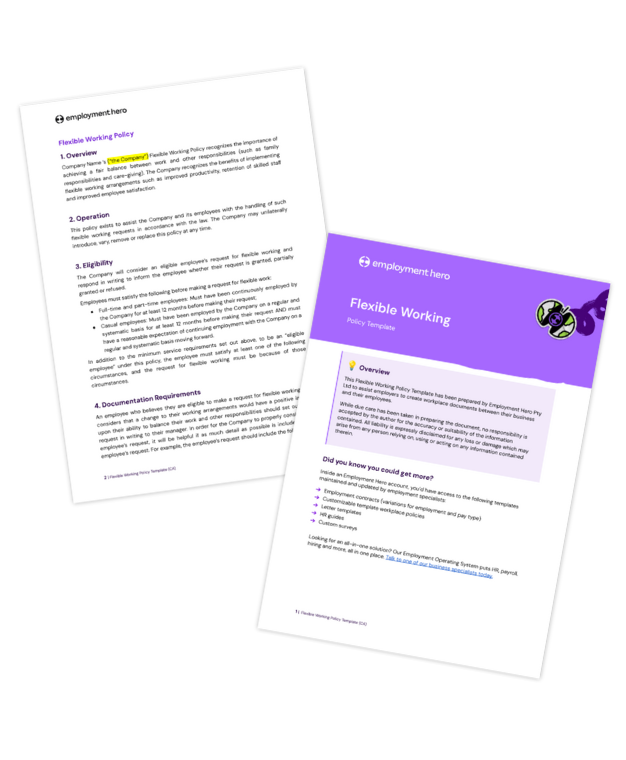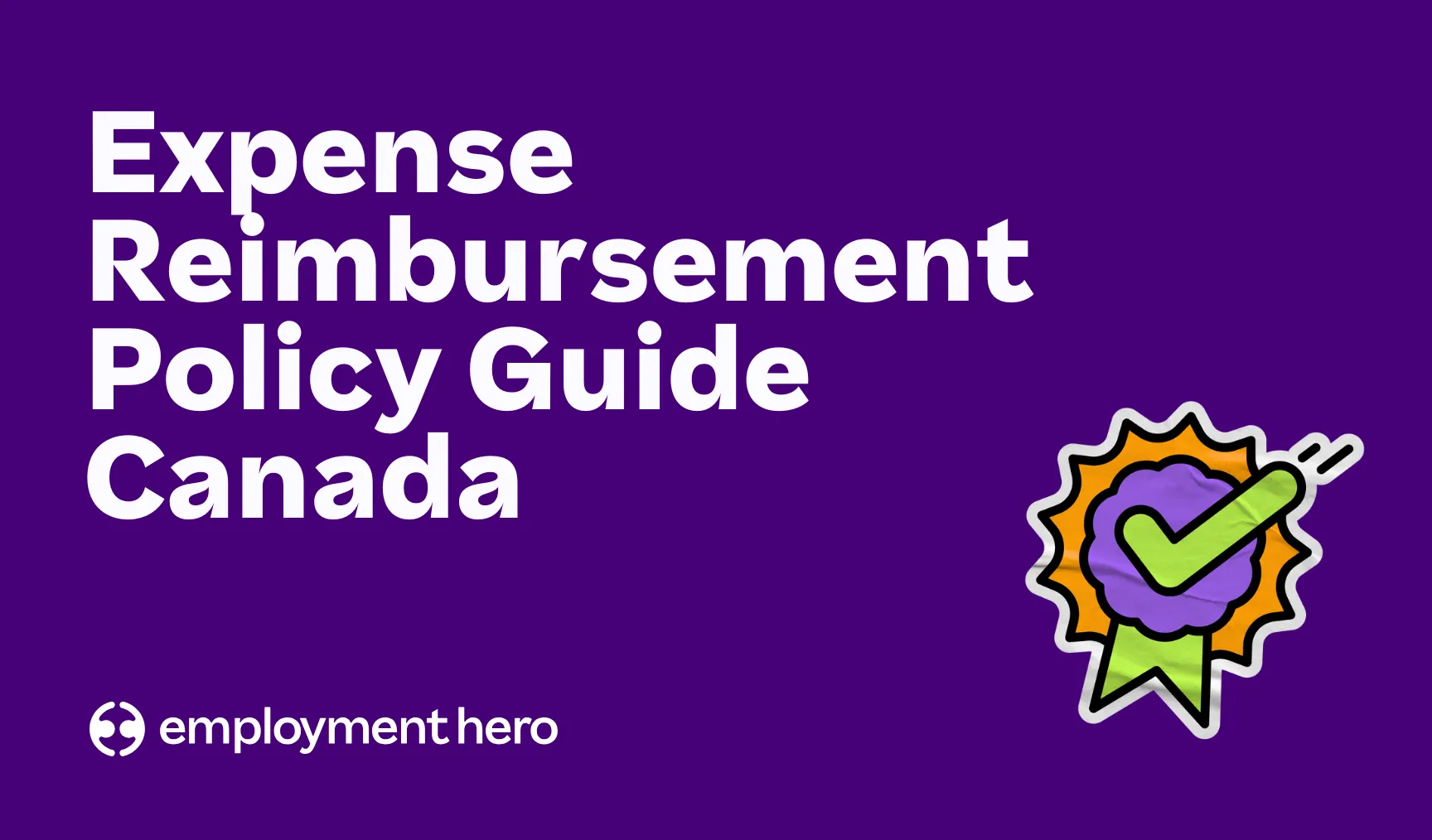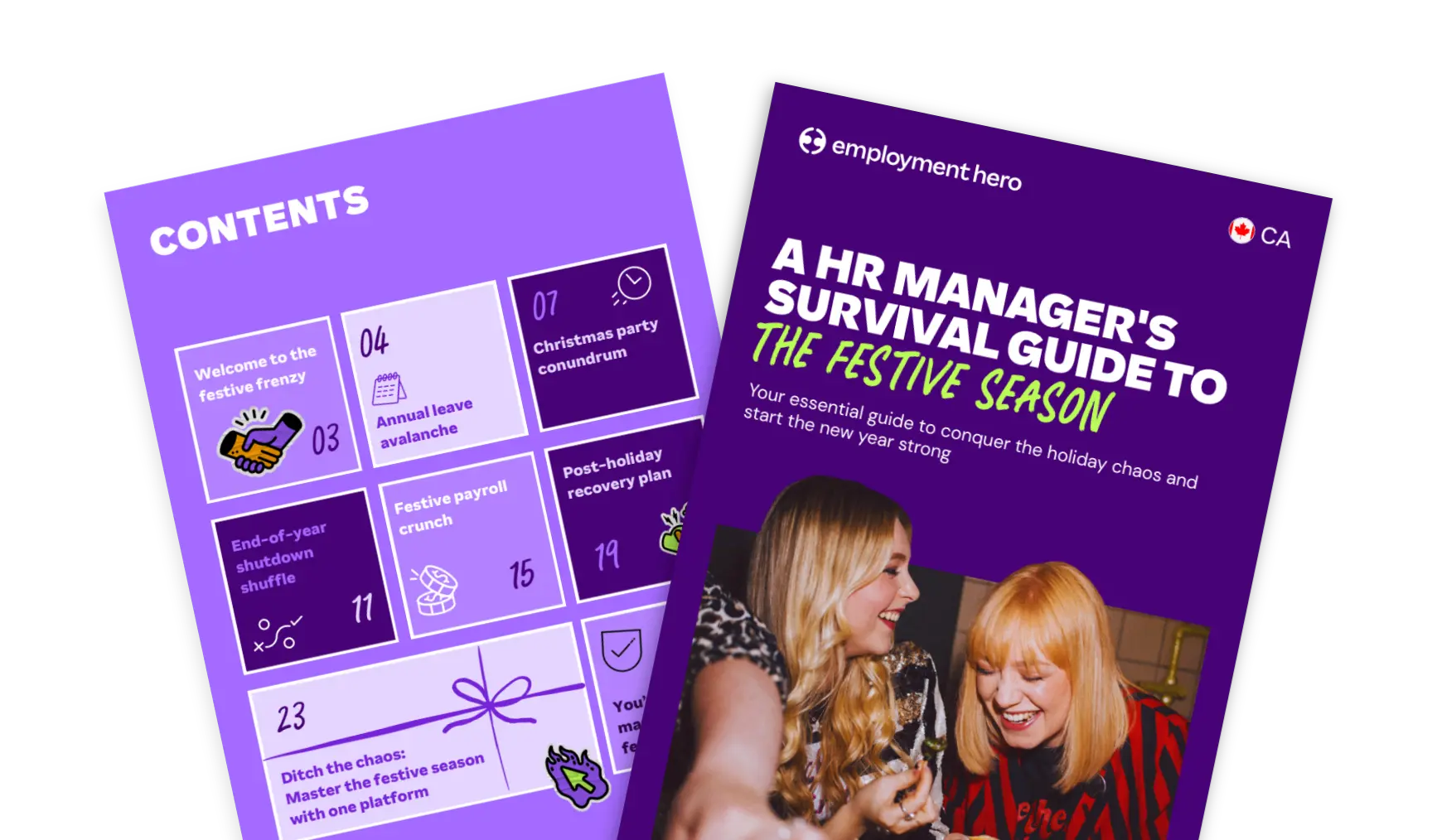Flexible work arrangements policy template and guide
Published
Flexible work arrangements policy template and guide
Published
In today’s dynamic work environment, offering flexible work arrangements isn’t just a perk; it’s a critical strategy for attracting top talent, boosting employee morale and ensuring your business stays competitive. As companies and employees alike navigate the shift toward more adaptable work models, having a clear and consistent policy is essential.
A well-designed policy provides the framework needed to balance business objectives with employee needs, ensuring fairness, productivity and supporting compliance. This comprehensive guide will walk you through the what, why and how of flexible work arrangements in a Canadian context. Plus, we’ve included a free, customizable policy template to help you get started right away.

What is in this flexible work arrangements policy template?
This comprehensive guide and accompanying template are designed to help Canadian businesses navigate the complexities of flexible work arrangements. By downloading our customizable policy template, you get a ready-to-use document that outlines the framework for employees to request and use flexible work options. This includes sections on eligibility, documentation requirements and the step-by-step procedure for a fair request and approval process.
What is a flexible work arrangements policy?
A flexible work arrangements policy is a written framework that outlines how and when employees can request and use flexible work options, such as remote work, compressed workweeks, job sharing or flexible start and end times. It’s more than just a document; it’s a tool that sets clear expectations for both employers and employees, creating a balance between a business’s operational needs and employee well-being. A well-defined policy ensures consistency, fairness and transparency for everyone involved.
Why Canadian businesses need one
The demand for flexible work in Canada has grown significantly, accelerated by the pandemic and supported by research showing its positive impact on productivity, employee retention, and work-life balance. Having a formal policy is crucial because it ensures that all requests are handled consistently and fairly. It also helps businesses comply with Canadian labour laws and human rights obligations, minimizing legal risks and fostering a supportive work environment.
Legal considerations in Canada
When it comes to flexible work, Canadian employment law is a key consideration. While there is no federal law that requires employers to offer flexible work, the Canada Labour Code does allow employees in federally regulated industries to request these arrangements. More importantly, provincial human rights laws may require employers to accommodate employees for reasons related to family status, disability or religious observances. A clear, written policy is essential for documenting how your business meets these critical legal and human rights obligations.
How to create a flexible work arrangements policy
Creating a flexible work policy doesn’t have to be complicated. The first step is to define the scope of flexible work options you’ll offer and the eligibility criteria for employees. From there, you’ll need to outline a clear process for how requests are made, reviewed and approved. A robust policy should also document the responsibilities of both employees and managers, and establish conditions for reviewing and adjusting arrangements over time.
Remember, a good policy must align with your existing obligations around occupational health and safety, privacy rules and performance expectations.
Instead of building one from scratch, you can save time by downloading our flexible work arrangements policy template.
Defining flexible work options
Your policy should clearly describe the different types of flexible work arrangements available to employees. These can include:
- Hybrid work: Employees split their time between the office and a remote location.
- Remote work: Employees work exclusively from a location outside of the office.
- Flexible hours: Employees have some control over their daily start and end times.
- Part-time work: Employees work fewer than the standard full-time hours.
- Job sharing: Two or more employees share the responsibilities of a single full-time role.
- Compressed workweek: Employees work full-time hours in fewer than five days (e.g., four 10-hour days).
It’s important to tailor these options to your business’s operational needs while being transparent about what is and isn’t available.
Request and approval process
A clear and objective request process is vital for avoiding discrimination. Your policy should provide step-by-step guidance for employees, including:
- The required forms or documentation.
- The timeline for submitting a request.
- Manager responsibilities for reviewing requests based on objective criteria.
This structured approach ensures fairness and transparency for everyone involved.
Roles, responsibilities, and expectations
To make a flexible work arrangement successful, both employees and managers must understand their roles. The policy should specify:
- Employee responsibilities: Committing to maintaining productivity, being available for communication, and meeting performance standards.
- Manager responsibilities: Fairly and consistently supporting flexible arrangements and ensuring team cohesion and performance are maintained.
Best practices for flexible work policies
A flexible work policy is most effective when it’s built on a foundation of fairness, transparency and ongoing support.
Fairness and inclusivity
A strong policy ensures equal access to flexible work for all employees, regardless of gender, family status, or role. When balancing operational needs, you must always be mindful of human rights obligations under Canadian law to avoid discrimination and foster an inclusive workplace.
Communication and technology
For flexible and remote work to be successful, businesses must provide the right tools and clear expectations. Your policy should outline:
- Communication expectations: How and when employees should be available.
- Technology access: Ensuring employees have the necessary technology and cybersecurity protections to work effectively and securely from anywhere.
Monitoring and review
Flexible work policies aren’t a one-and-done solution. Regularly reviewing arrangements is a best practice to assess their effectiveness and gather employee feedback. This helps you identify what’s working and what isn’t, allowing you to make periodic updates to ensure the policy remains relevant and beneficial for both your business and your employees.
Flexible work policy template
Here’s a preview of the letter template you can download and customize based on your requirements:

Benefits of a flexible working policy
A flexible work policy delivers significant advantages for both businesses and their employees.
For employees, flexible arrangements can lead to:
- Improved work-life balance.
- Reduced commuting stress and costs.
- Greater job satisfaction and engagement.
For employers, the benefits are equally compelling:
- Higher retention of skilled talent.
- An expanded talent pool by attracting candidates who value flexibility.
- Increased productivity and performance.
- Enhanced employer branding, making your company a more desirable place to work.
Industry-specific considerations
A flexible work policy is not a one-size-fits-all solution. Its design and implementation need to be adapted to your industry’s specific operational realities. For example, office-based roles are often well-suited for hybrid or remote work, while industries like healthcare, hospitality or manufacturing may rely more on options like flexible hours, shift-swapping or part-time arrangements to accommodate operational needs. The key is to tailor your policy to your business while always respecting employee rights and needs.
Download our flexible working arrangements policy template
Ready to create a professional and legally sound flexible work policy for your business? Download our customizable flexible working arrangements policy template today. It’s a quick and simple way to provide clarity, ensure compliance and empower your team.
The information in this template is current as at 1 August 2025, and has been prepared by Employment Hero Pty Ltd (ABN 11 160 047 709) and its related bodies corporate (Employment Hero). The content is general information only, is provided in good faith to assist employers and their employees, and should not be relied on as professional advice. Some information is based on data supplied by third parties. While such data is believed to be accurate, it has not been independently verified and no warranties are given that it is complete, accurate, up to date or fit for the purpose for which it is required. Employment Hero does not accept responsibility for any inaccuracy in such data and is not liable for any loss or damages arising directly or indirectly as a result of reliance on, use of or inability to use any information provided in this template. You should undertake your own research and seek professional advice before making any decisions or relying on the information in this template.

Register for the template
Related Resources
-
 Read more: Expense Reimbursement Policy Guide Canada
Read more: Expense Reimbursement Policy Guide CanadaExpense Reimbursement Policy Guide Canada
Download a free expense reimbursement policy guide for Canadian businesses. Learn how to create a clear, compliant policy for managing…
-
 Read more: The professional development plan Canada’s top teams use
Read more: The professional development plan Canada’s top teams useThe professional development plan Canada’s top teams use
Download a free professional development plan template for Canadian businesses. Help employees set goals, track progress and achieve career growth.
-
 Read more: HR Managers: Don’t just survive the festive season, master it
Read more: HR Managers: Don’t just survive the festive season, master itHR Managers: Don’t just survive the festive season, master it
Make year-end easier: manage time-off, payroll, parties and shutdowns with confidence. Get practical tips for Canadian SMBs. Download the free…


















